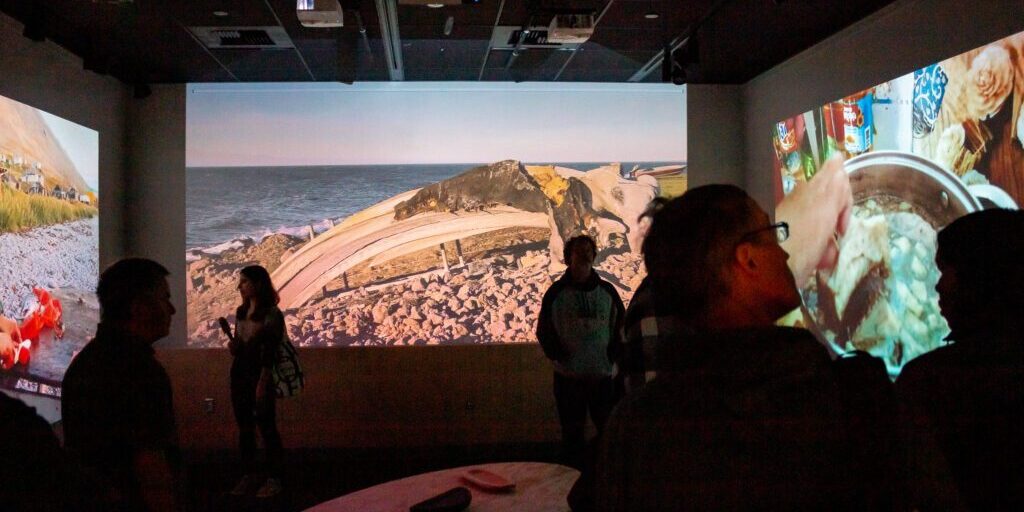A new multimedia exhibit at the Carrie M. McLain Memorial Museum until October showcases traditional native foods and the ways they are prepared throughout the Bering Strait region.
KNOM’s Katie Kazmierski reports on how the exhibit incorporates footage from both the U.S. and Russian sides of the Bering Strait:
“It was a beautiful day in July, and the hunters came to that camp where we’re staying… It’s in Nunyamo, it’s on the Russian side, between Lavrentiya and Uelen. It’s actually not far from here.”
As he speaks, Igor Pasternak watches his own footage from July of 2017. In it, a subsistence hunter works carefully, processing walrus blubber by the shore, from one of several walruses harvested that day. The water near where he stands is bright red.
“He is making a tuktaq. He’s making a roll out of the walrus skin and blubber, so they’re going to stuff it with some organs. They’re gonna put the kidney and the heart, and a piece of liver inside of this and let it sit and ferment.”
The clip is projected on the entire wall in the exhibit room in the Carrie M. McLain Memorial Museum. Another wall displays footage of a woman mixing together tundra greens, while another, still, shows kids jumping on and off of the tail of a whale, as men work to harvest it.
The footage is all part of the multimedia exhibit “Aging with Change: Food Arts in The Bering Strait,” which is currently on display in Nome. It’s a joint effort by Igor Pasternak and Sveta Yamin-Pasternak, both professors at University of Alaska–Fairbanks, who have spent 20 years studying Bering Strait foodways. Sveta welcomed visitors to the exhibit’s opening on July 12.
Sveta: “This is made for sitting, put your elbows on the table.” [laughter]
Participant: “Which are we watching?”
Sveta: “Well, it’s up to you! You can take turns.” [She laughs.]
The video clips projected on each wall light up the dimly-lit space, and visitors gather around a table, as they lounge on reindeer hides.

Igor and Sveta Yamin-Pasternak call the exhibit “a tribute to the passion and expertise of the many Yupik, Inupiaq, and Chukchi food artists on the U.S. and Russian sides of the Bering Strait.”
The “aging” part of “Aging With Change” comes from the role of aging and fermentation in the making of many native dishes in the region.
“‘Change’ refers to both social and environmental change to which people continue to adapt their ways of doing food.”
The “change” component is one of the aspects that makes the exhibit timely this day and age. Igor Pasternak says this is evident in how many communities are starting to incorporate different ingredients in their traditional foods.
“Let’s say, like, soy sauce… you go to St. Lawrence Island, and there are like, two, three different kinds of soy sauce today in a village store, although it’s a tiny, tiny store.”
Differences in regional food preparation extend beyond new ingredients, and the Pasternaks say people throughout the 15 different communities they’ve worked in recognize that — and want to know more.
“People really always want to know: how do they work with this particular material, with the products from this animal, from these plants. And how do they put them together in the neighboring villages or the villages on the Russian side of the Bering Strait… This show is just another step in the process with continuing to have this sharing, this knowledge exchange.”
Sue Steinacher, Nome resident and visitor to the exhibit, echoed that she’s noticed a vast variety in the way traditional foods are produced in her travels throughout the region. She applauded the exhibit for using photography and videography to engage the viewer in those differences.
“How the Diomeders split walrus skins for skin boats is completely different than how the St. Lawrence Islanders do. And what I saw in the village of Sireniki (Russia) was entirely different than either of those. So it’s fascinating. Everybody’s headed to a similar endpoint of edible, cherished food, and yet there may be a lot of differences in how they get to that same point.”
“Aging With Change” is open to the public at the Carrie M. McLain Memorial Museum until October 18.
Beyond that, Sveta Yamin-Pasternak and Igor Pasternak say they want the conversations the exhibit might inspire to expand and continue, and they look forward to hearing communities’ comments, which can be submitted in the comment book at the museum or via email at gipasternak@alaska.edu or syamin@alaska.edu.
Image at top: Inside “Aging With Change.” Photo: JoJo Phillips, KNOM.




